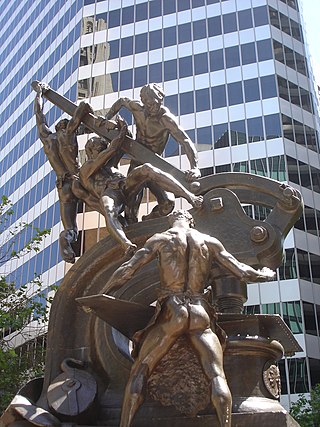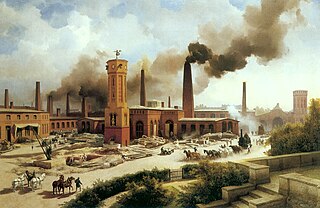
A social class or social stratum is a grouping of people into a set of hierarchical social categories, the most common being the working class, middle class, and upper class. Membership of a social class can for example be dependent on education, wealth, occupation, income, and belonging to a particular subculture or social network.

The bourgeoisie are a class of business owners, merchants and wealthy people, in general, which emerged in the Late Middle Ages, originally as a "middle class" between peasantry and aristocracy. They are traditionally contrasted with the proletariat by their wealth, political power, and education, as well as their access to and control of cultural, social, and financial capital.

Social class in the United States refers to the idea of grouping Americans by some measure of social status, typically by economic status. However, it could also refer to social status and/or location. The idea that American society can be divided into social classes is disputed, and there are many competing class systems.

A blue-collar worker is a person who performs manual labor or skilled trades. Blue-collar work may involve skilled or unskilled labor. The type of work may involve manufacturing, retail, warehousing, mining, excavation, carpentry, electricity generation and power plant operations, electrical construction and maintenance, custodial work, farming, commercial fishing, logging, landscaping, pest control, food processing, oil field work, waste collection and disposal, recycling, construction, maintenance, shipping, driving, trucking, and many other types of physical work. Blue-collar work often involves something being physically built or maintained. In social status, blue-collar workers generally belong to the working class.

The middle class refers to a class of people in the middle of a social hierarchy, often defined by occupation, income, education, or social status. The term has historically been associated with modernity, capitalism and political debate. Common definitions for the middle class range from the middle fifth of individuals on a nation's income ladder, to everyone but the poorest and wealthiest 20%. Theories like "Paradox of Interest" use decile groups and wealth distribution data to determine the size and wealth share of the middle class.

Petite bourgeoisie is a term that refers to a social class composed of small business owners, shopkeepers, small-scale merchants, semi-autonomous peasants, and artisans. They are named as such because their politico-economic ideological stance in times of stability is reflective of the proper haute bourgeoisie. In regular times, the petite bourgeoisie seek to identify themselves with the haute bourgeoisie, whose bourgeois morality, conduct and lifestyle they aspire and strive to imitate.

Social stratification refers to a society's categorization of its people into groups based on socioeconomic factors like wealth, income, race, education, ethnicity, gender, occupation, social status, or derived power. It is a hierarchy within groups that ascribe them to different levels of privileges. As such, stratification is the relative social position of persons within a social group, category, geographic region, or social unit.
The social structure of the United Kingdom has historically been highly influenced by the concept of social class, which continues to affect British society today. British society, like its European neighbours and most societies in world history, was traditionally divided hierarchically within a system that involved the hereditary transmission of occupation, social status and political influence. Since the advent of industrialisation, this system has been in a constant state of revision, and new factors other than birth are now a greater part of creating identity in Britain.

The social structure of China has an expansive history which begins from the feudal society of Imperial China to the contemporary era. There was a Chinese nobility, beginning with the Zhou dynasty. However, after the Song dynasty, the powerful government offices were not hereditary. Instead, they were selected through the imperial examination system, of written examinations based on Confucian thought, thereby undermining the power of the hereditary aristocracy.
The structure of social class in Cambodia has altered several times throughout its history. The traditional hereditary elites were marginalised in the 1970s, when military leaders gained prominence, before the Khmer Rouge attempted to dramatically eliminate existing class structures in the late 1970s. Since the emergence of peace in the early 1990s, social inequality has increased in Cambodia.
Marxian class theory asserts that an individual's position within a class hierarchy is determined by their role in the production process, and argues that political and ideological consciousness is determined by class position. A class is those who share common economic interests, are conscious of those interests, and engage in collective action which advances those interests. Within Marxian class theory, the structure of the production process forms the basis of class construction.
Economic restructuring is used to indicate changes in the constituent parts of an economy in a very general sense. In the western world, it is usually used to refer to the phenomenon of urban areas shifting from a manufacturing to a service sector economic base. It has profound implications for productive capacities and competitiveness of cities and regions. This transformation has affected demographics including income distribution, employment, and social hierarchy; institutional arrangements including the growth of the corporate complex, specialized producer services, capital mobility, informal economy, nonstandard work, and public outlays; as well as geographic spacing including the rise of world cities, spatial mismatch, and metropolitan growth differentials.
Belize's social structure is marked by enduring differences in the distribution of wealth, power, and prestige. Because of the small size of Belize's population and the intimate scale of social relations, the social distance between the rich and the poor, while significant, is nowhere as vast as in other Caribbean and Central American societies, such as Jamaica and El Salvador. Belize lacks the violent class and racial conflict that has figured so prominently in the social life of its Central American people.
A commoner, also known as the common man, commoners, the common people or the masses, was in earlier use an ordinary person in a community or nation who did not have any significant social status, especially a member of neither royalty, nobility, nor any part of the aristocracy. Depending on culture and period, other elevated persons may have had higher social status in their own right, or were regarded as commoners if lacking an aristocratic background.
Social classes in Italy are bourgeoisie, white-collar middle class, urban petite bourgeoisie, rural petite bourgeoisie, urban working class and rural working class.

Bildungsbürgertum was a social class that emerged in mid-18th-century Germany as the educated social stratum of the bourgeoisie. It was a cultural elite that had received an education based on the values of idealism and classical studies and which steered public opinion in art and patterns of behaviour. The majority of its members were Protestant and employed in the upper civil service and free professions such as law, journalism and the arts. Despite its influence, the Bildungsbürgertum never exceeded more than about one percent of the population.

The working class is a subset of employees who are compensated with wage or salary-based contracts, whose exact membership varies from definition to definition. Members of the working class rely primarily upon earnings from wage labour. Most common definitions of "working class" in use in the United States limit its membership to workers who hold blue-collar and pink-collar jobs, or whose income is insufficiently high to place them in the middle class, or both. However, socialists define "working class" to include all workers who fall into this category; thus, this definition can include almost all of the working population of industrialized economies.
The proletariat is the social class of wage-earners, those members of a society whose possession of significant economic value is their labour power. A member of such a class is a proletarian or a proletaire. Marxist philosophy regards the proletariat under conditions of capitalism as an exploited class forced to accept meager wages in return for operating the means of production, which belong to the class of business owners, the bourgeoisie.

Elite overproduction is a concept developed by Peter Turchin that describes the condition of a society that is producing too many potential elite members relative to its ability to absorb them into the power structure. This, he hypothesizes, is a cause for social instability, as those left out of power feel aggrieved by their relatively low socioeconomic status.

Industrialization in Germany was the phase of the breakthrough of industrialization in Germany, beginning at the time from around 1815 to 1835. This period was preceded by the periods of pre-industrialization and early industrialization. In general, the decades between the 1830s and 1873 are considered the phase of industrial take off. The Industrial Revolution was followed by the phase of high industrialization during the German Empire. The (catch-up) Industrial Revolution in Germany differed from that of the pioneering country of Great Britain in that the key industries became not the textile industry but coal production, steel production and railroad construction.












